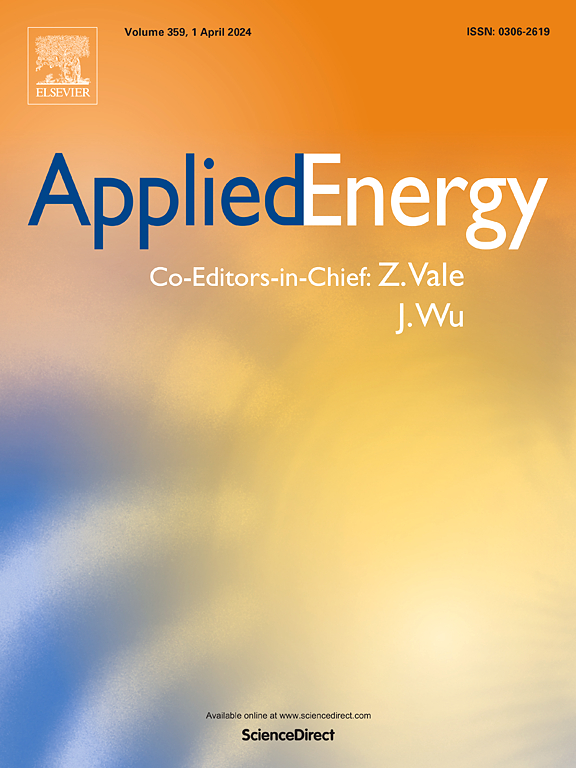密集城市环境下基于无人机野外摄影的屋顶光伏电势精确量化研究
IF 10.1
1区 工程技术
Q1 ENERGY & FUELS
引用次数: 0
摘要
准确和详细的屋顶光伏(PV)安装潜力估计对于指导屋顶光伏部署策略非常重要,从而加速向碳中和的进展。屋顶光伏安装系数是估算屋顶光伏可安装面积的关键参数。现有方法通常通过在没有安装光伏系统的屋顶上设计假设布局来估计屋顶光伏安装系数。然而,这种方法可能导致安装后观察到的实际安装系数存在差异。本研究提出了一种基于从大量现有光伏装置的建筑物中收集的真实数据来确定屋顶光伏装置系数的方法。利用无人机(UAV)摄影技术快速、全面地捕捉屋顶光伏安装信息,包括光伏与屋顶面积的比例、建筑类型、屋顶类型、安装方式等。对中国三个城市279栋建筑的光伏安装数据进行了收集和分析。推导了6种建筑类型的屋顶光伏安装系数,可用于估算全市屋顶光伏安装潜力。以武汉市中心城区为例,计算了不同功能区的光伏装机潜力和单体建筑的平均装机潜力。结果表明:武汉市不同建筑类型的屋顶光伏安装系数在0.26 ~ 0.50之间,全市平均系数为0.32;这些值明显低于之前大多数没有纳入实际安装数据的研究报告。武汉中心城区屋顶光伏安装面积潜力估计为38平方公里,最大发电潜力约为9308 GWh/年。根据武汉2024年的总用电量,这可以满足该市18.9%的总电力需求本文章由计算机程序翻译,如有差异,请以英文原文为准。
An accurate quantification study on the rooftop PV potential based UAV field photography in dense urban environments
An accurate and detailed estimation of rooftop photovoltaic (PV) installation potential is important for guiding rooftop PV deployment strategies, thereby accelerating progress toward carbon neutrality. The rooftop PV installation coefficient is a key parameter for estimating the rooftop installable PV areas. Existing methods typically estimate the rooftop PV installation coefficient by designing hypothetical layouts on rooftops without installed PV systems. However, such approaches may lead to discrepancies from the actual installation coefficients observed after installation. This study proposes a method for determining rooftop PV installation coefficients based on real-world data collected from a large number of buildings with existing PV installations. Unmanned aerial vehicle (UAV) photography is employed to rapidly and comprehensively capture rooftop PV installation information, including the ratio of PV to rooftop area, building type, roof type, and installation method. PV installation data from 279 buildings across three cities in China have been collected and analyzed. Rooftop PV installation coefficients were derived for six building types, which can be applied to estimate the city-wide rooftop PV installation potential. Taking Wuhan central urban area as a case study, the PV installation potential of different functional zones and the average installation potential of individual buildings have been calculated. The results indicate that the rooftop PV installation coefficients for various building types in Wuhan range from 0.26 to 0.50, with an overall citywide average of 0.32. These values are significantly lower than those reported in most previous studies that did not incorporate actual installation data. The rooftop PV installation area potential in Wuhan central urban is estimated at 38 km2, with a maximum power generation potential of approximately 9308 GWh/year. Based on Wuhan's total electricity consumption in 2024, this could meet 18.9 % of the city's total electricity demand
求助全文
通过发布文献求助,成功后即可免费获取论文全文。
去求助
来源期刊

Applied Energy
工程技术-工程:化工
CiteScore
21.20
自引率
10.70%
发文量
1830
审稿时长
41 days
期刊介绍:
Applied Energy serves as a platform for sharing innovations, research, development, and demonstrations in energy conversion, conservation, and sustainable energy systems. The journal covers topics such as optimal energy resource use, environmental pollutant mitigation, and energy process analysis. It welcomes original papers, review articles, technical notes, and letters to the editor. Authors are encouraged to submit manuscripts that bridge the gap between research, development, and implementation. The journal addresses a wide spectrum of topics, including fossil and renewable energy technologies, energy economics, and environmental impacts. Applied Energy also explores modeling and forecasting, conservation strategies, and the social and economic implications of energy policies, including climate change mitigation. It is complemented by the open-access journal Advances in Applied Energy.
 求助内容:
求助内容: 应助结果提醒方式:
应助结果提醒方式:


